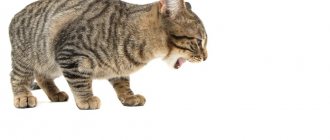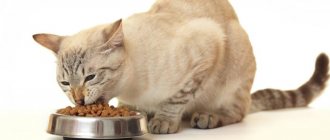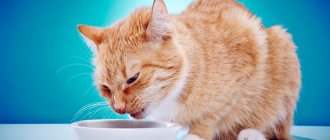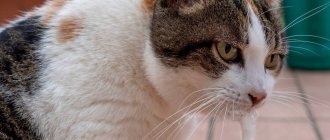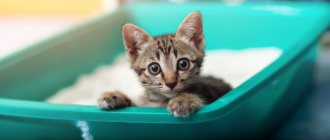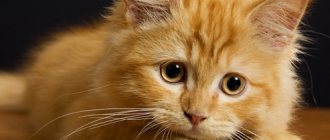Vomiting is one of the main protective reflexes of the gastrointestinal tract in animals. In this way, the body tries to get rid of mechanical, chemical irritants, foreign bodies and toxins. Seeing that his pet is vomiting, any owner will become alarmed and wonder what caused the problem. cat vomiting white foam and how to help your pet. When cat vomiting white foam comes out, this is one of the reactions of the cat’s body and there are many reasons for this. You should consider all possible options and choose the right one. algorithm of actions, since you can miss the onset of the disease and lose favorable time for its rapid treatment.
If a cat vomits pure white foam , this is a sign of an empty stomach.
, which contains only hydrochloric acid, the secretion of the salivary glands and gastric enzymes.
When this mixture comes into contact with air, it foams. Often a cat vomits white foam on an empty stomach, for example, in the morning before you feed it. If this happens once , then most likely there is no cause for concern
and your cat is completely healthy.
Worry when
This symptom occurs repeatedly and is accompanied by other signs:
- in addition to vomiting, the animal refuses to eat;
- the foam has a pinkish tint, that is, stained with blood;
- vomiting accompanied by diarrhea;
- the cat is lethargic, depressed, apathetic;
- foul odor of vomit;
- the temperature rises or falls.
Causes of vomiting in cats and kittens
Vomiting white foam in cats and kittens can be a protective reaction to the entry of pathogenic bacteria and irritating substances into the digestive system.
This symptom may appear if the animal has eaten something wrong. Pay attention to the vomit. Don't worry if the white foam is a smooth consistency. This may mean a temporary disruption to the digestive system.
Let's look at why a kitten may vomit white foam:
- Overeating, feeding too large pieces of food.
- Hunger. If an animal does not eat for a long enough time, gastric juice begins to irritate the mucous membranes of the digestive organs. As a result, the kitten vomits white foam.
- Too abrupt a transition from one diet to another.
- Feeding food that is harmful to the kitten (fatty, fried, smoked).
- Stale food, ready-made economy class rations.
- Eating inedible objects.
- Poisoning with chemicals (household chemicals, medications, alcohol).
- Consequences of vaccination.
- Inflammatory diseases of the gastrointestinal tract. Symptoms appear immediately after feeding. The kitten first burps, then vomits. If severe diarrhea is added to vomiting, the animal may die.
- Kidney diseases. Vomiting is accompanied by thirst and difficulty urinating.
- Infectious diseases. The most dangerous are feline distemper and panleukopenia, which can be fatal. The kitten vomits white or yellowish foam, attacks occur quite often.
- Respiratory diseases of viral, bacterial etiology. In this case, vomiting is accompanied by a cough, and a small amount of blood is present in the foam.
- Inflammatory diseases of the adrenal glands. The result is a disruption of the normal process of cortisone synthesis, which is accompanied by vomiting, diarrhea, and muscle weakness.
- Worm infestation. Vomiting is caused by toxins that are formed during the life of parasites.
A possible cause of vomiting may be a large amount of fur entering the stomach if the animal licks itself frequently. This process is typical for long-haired animals.
Why does a pregnant cat vomit?
Pregnant cat
Pregnancy is a complex process that causes changes in the cat's body. Vomiting is one of the symptoms of pregnancy. There is no need to worry about the expectant mother; nausea is a normal process during pregnancy.
But why does the cat feel sick?
During pregnancy, hormonal levels change. The uterus increases in size, and other internal organs are compressed. The fetus can put pressure on the organs, so after the usual meal, the cat may vomit.
The cat's body becomes sensitive during pregnancy. It rejects toxic substances, resulting in frequent vomiting.
White vomit is a normal reaction, so there is no need to worry. But if blood or bile is released, you need to go to the veterinarian so as not to endanger your pet.
What to do if your cat is vomiting?
So, what should you do if your cat is vomiting white foam? Observe your pet for 24 hours. If your cat vomits but is still acting normally, signs of discomfort may disappear the next day.
If you suspect poisoning or an exacerbation of gastrointestinal diseases, you can try to help the cat by giving it a fasting day. This will restore the functioning of the damaged organ.
The next day, the animal’s condition should return to normal and the vomiting should stop. On the first day after the fasting day, give your cat rice cooked in chicken broth.
Feed your pet more often (up to 6 times a day), in small portions. In subsequent days, reduce the number of feedings and increase the amount of food. Then gradually transition the cat to a regular diet.
If the vomiting was caused by a common stomach upset, give your pet a mint infusion. Pour 1 teaspoon of herb into 1 cup of boiling water and leave until cool. The drink should be warm. Give your cat 1 tablespoon immediately after vomiting.
First aid
To improve your pet's condition, you can give him a mint decoction a little at a time.
When a cat vomits foam and other unpleasant symptoms appear, owners should know how to alleviate the condition of their pet. If your pet vomits once and his health is normal after that, then there is no need to sound the alarm. It is recommended to give the cat rest and not feed him for several hours. In this way, it will be possible to relieve the digestive organs and restore their functioning. The next day, if the cat no longer vomits, then it is allowed to give boiled rice based on chicken broth. Meals should be small but frequent. It is useful to make a decoction of mint as first aid when a cat is vomiting foam. If your pet refuses to take it, you can try pouring the medicine into the mouth using a syringe. When the animal does not stop burping foamy saliva, and its condition quickly worsens, it is necessary to immediately take the patient to a veterinary clinic.
In what cases should you contact a veterinarian?
The situation becomes more complicated when the pet feels sick and vomits for more than a day, it becomes weak and lethargic and looks sick. If the cat does not go to the toilet or does not allow his stomach to be touched, you should urgently contact a veterinarian.
Other reasons to contact a specialist:
- After a starvation diet, the pet’s condition does not improve; he often vomits (several times an hour).
- If your cat doesn't eat anything all day. In this case, foamy vomit is most likely a sign of a serious illness.
- Vomiting is accompanied by severe thirst, and the cat does not go to the litter box. This indicates kidney pathology.
- Diarrhea, fever (above 38-39 ºС).
- Cramps. The symptom indicates damage to the central nervous system.
- Bloody discharge can be seen in the vomit.
- If your cat regularly spits up fur, his digestive system is not working properly. Your pet may have diseases of the gallbladder, pancreas or rectum.
Vomiting that does not stop for more than a day leads to dehydration. This condition poses a serious threat to life.
The following sign indicates severe dehydration with prolonged vomiting: lift an area of skin with your fingers and release it, it will slowly return to its original shape.
To prevent the death of the animal, you should not self-medicate. Be sure to show your cat to a veterinarian, who will determine the cause of vomiting and provide adequate therapy.
Symptoms
Foaming at the mouth of a cat is a cause for concern for the animal owner. The cause may be either a normal physiological condition (with regurgitation of hairballs) or the development of serious dangerous diseases (rabies). Especially if the saliva foams at the mouth. In such cases, it is recommended to immediately isolate the cat and take it to a veterinary clinic.
The appearance of foam in a cat’s mouth when vomiting, which occurs as a result of prolonged fasting, intoxication, and stressful experiences, as a rule, is not distinguished by other characteristic signs other than nausea. The erupted gastric contents have no foreign odors or impurities.
If there are foreign impurities in the vomit, an unusual yellow or green color, as well as a foul odor, you must contact a veterinary hospital and show your pet to a doctor. The appearance of the following characteristic symptoms requires immediate intervention from a specialist:
- the cat vomits too often, vomiting almost never stops;
- body temperature increases or, on the contrary, decreases;
- there is a cough, discharge from the eye and nasal cavity;
- appetite is impaired;
- the general condition of the animal is depressed;
- profuse diarrhea appears.
When a cat vomits pink liquid with foam, you cannot hesitate. The cause of such vomiting may be a stomach ulcer or a perforation of the esophagus. Pink color indicates blood impurities and indicates damage to the mucous membrane of one part of the digestive tract.
The color and presence of particles in the vomit can characterize the degree of neglect of the pathological condition:
- vomit with white foam is most often a sign of prolonged starvation of a pet;
- the presence of mucous white inclusions in the liquid ejected by the stomach indicates that the cat is infected with helminths;
- if a cat is vomiting yellow foam, the cause may be a dangerous illness - carnivore plague or panleukopenia;
- the gray color of the vomit indicates a violation of the diet and the presence of remains of granulated food;
- dark green, almost black color of vomit may be evidence of oncology in the digestive tract;
- yellow vomiting occurs when there is a violation of the functional characteristics of the gallbladder and liver structures;
- vomiting in a green fountain – intestinal obstruction;
- vomiting with feces is a sign of injury to the lower intestines.
Severe, ongoing nausea and vomiting lead to rapid dehydration and disruption of water and electrolyte balance. Visible mucous membranes turn pale, become dry, and saliva is viscous. The animal is depressed, and in advanced cases, seizures or convulsions are noted. It is important to contact a specialist in a timely manner, since any delay can result in the death of the cat.
What to do if your cat is vomiting yellow foam?
If a cat vomits yellow foam, it means that bile has entered its stomach. The cause is diseases of the gastrointestinal tract (gastritis, colitis), biliary tract.
Yellowish vomiting in a cat can occur due to calcivirosis, a sudden change in diet, or a foreign body entering the stomach. If your pet has eaten stale or low-quality food, the load on the liver increases. In this case, vomiting of yellow liquid may also occur.
If you suspect that an inedible object or poor-quality food has entered the stomach, you need to provoke vomiting.
Give the animal a saline solution. To prepare it, stir 1 tablespoon of salt in 1 glass of warm water. Drink the solution until the cat begins to vomit.
If vomiting yellow foam was caused by poisoning, give your pet activated charcoal. In case of exacerbations of gastrointestinal diseases, exclude rough, fatty foods from the animal’s diet.
In severe cases, when vomiting with yellow foam was caused by infections, the cat should be taken to the veterinarian. In this case, you need to make droppers with saline solutions and medications.
Animal treatment
Cat treatment
The nature and methods of treatment are determined depending on the cause of vomiting.
If the cause is overeating, you need to adjust the animal's diet. Depending on age, weight, breed and activity, set feeding standards. Do not give your cat fatty, fried, spicy or sweet foods. Feed with natural products: low-fat dairy products, boiled meat, vegetables. If you feed your animal dry food, then it is advisable to buy premium, super-premium and holistic products. You also need to ensure plenty of fluids.
In severe cases, medical intervention is required. Before visiting the veterinarian, you should put your pet on a starvation diet.
